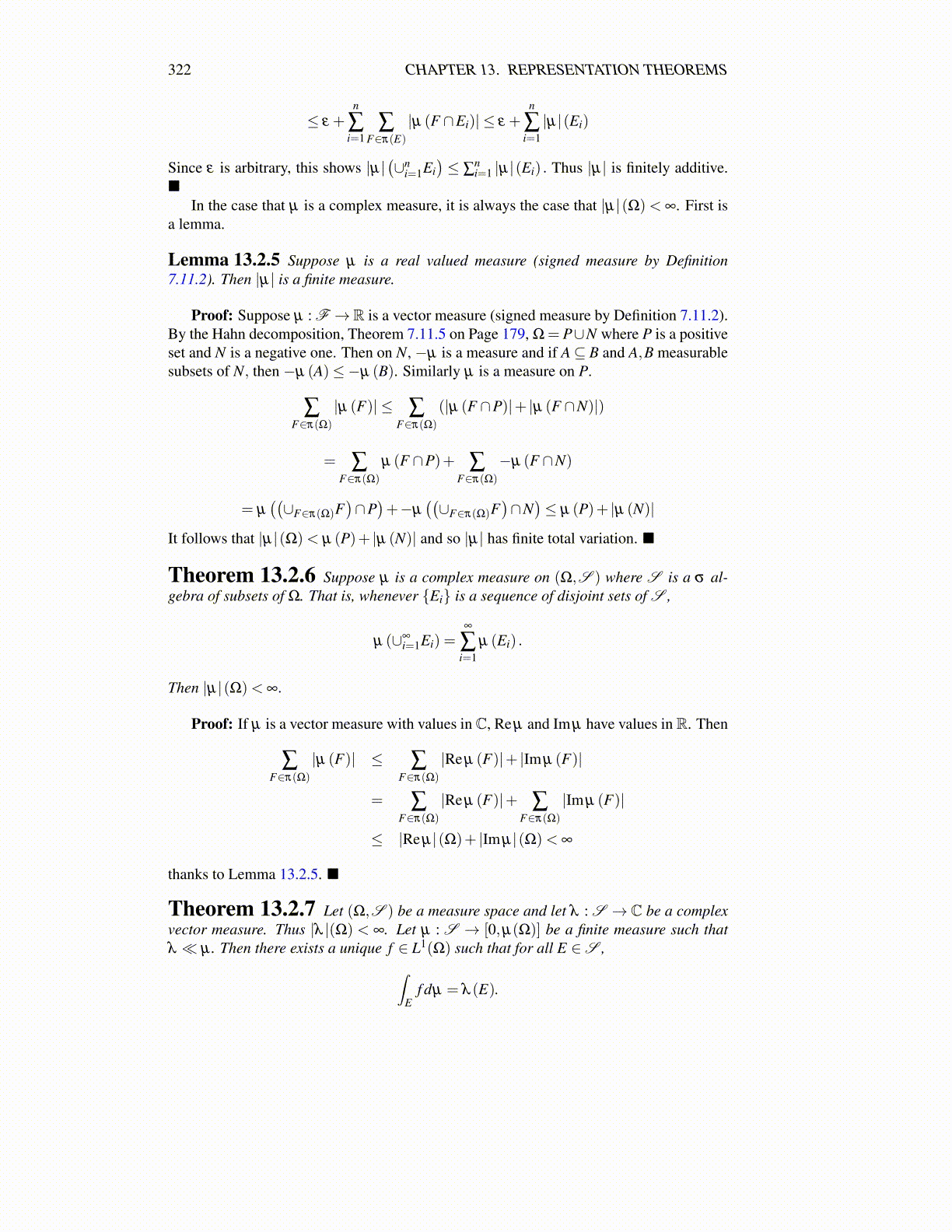
322 CHAPTER 13. REPRESENTATION THEOREMS
≤ ε +n
∑i=1
∑F∈π(E)
|µ (F ∩Ei)| ≤ ε +n
∑i=1|µ|(Ei)
Since ε is arbitrary, this shows |µ|(∪n
i=1Ei)≤ ∑
ni=1 |µ|(Ei) . Thus |µ| is finitely additive.
■In the case that µ is a complex measure, it is always the case that |µ|(Ω)< ∞. First is
a lemma.
Lemma 13.2.5 Suppose µ is a real valued measure (signed measure by Definition7.11.2). Then |µ| is a finite measure.
Proof: Suppose µ : F →R is a vector measure (signed measure by Definition 7.11.2).By the Hahn decomposition, Theorem 7.11.5 on Page 179, Ω = P∪N where P is a positiveset and N is a negative one. Then on N, −µ is a measure and if A⊆ B and A,B measurablesubsets of N, then −µ (A)≤−µ (B). Similarly µ is a measure on P.
∑F∈π(Ω)
|µ (F)| ≤ ∑F∈π(Ω)
(|µ (F ∩P)|+ |µ (F ∩N)|)
= ∑F∈π(Ω)
µ (F ∩P)+ ∑F∈π(Ω)
−µ (F ∩N)
= µ((∪F∈π(Ω)F
)∩P)+−µ
((∪F∈π(Ω)F
)∩N)≤ µ (P)+ |µ (N)|
It follows that |µ|(Ω)< µ (P)+ |µ (N)| and so |µ| has finite total variation. ■
Theorem 13.2.6 Suppose µ is a complex measure on (Ω,S ) where S is a σ al-gebra of subsets of Ω. That is, whenever {Ei} is a sequence of disjoint sets of S ,
µ (∪∞i=1Ei) =
∞
∑i=1
µ (Ei) .
Then |µ|(Ω)< ∞.
Proof: If µ is a vector measure with values in C, Re µ and Im µ have values in R. Then
∑F∈π(Ω)
|µ (F)| ≤ ∑F∈π(Ω)
|Re µ (F)|+ |Im µ (F)|
= ∑F∈π(Ω)
|Re µ (F)|+ ∑F∈π(Ω)
|Im µ (F)|
≤ |Re µ|(Ω)+ |Im µ|(Ω)< ∞
thanks to Lemma 13.2.5. ■
Theorem 13.2.7 Let (Ω,S ) be a measure space and let λ : S → C be a complexvector measure. Thus |λ |(Ω) < ∞. Let µ : S → [0,µ(Ω)] be a finite measure such thatλ ≪ µ . Then there exists a unique f ∈ L1(Ω) such that for all E ∈S ,∫
Ef dµ = λ (E).